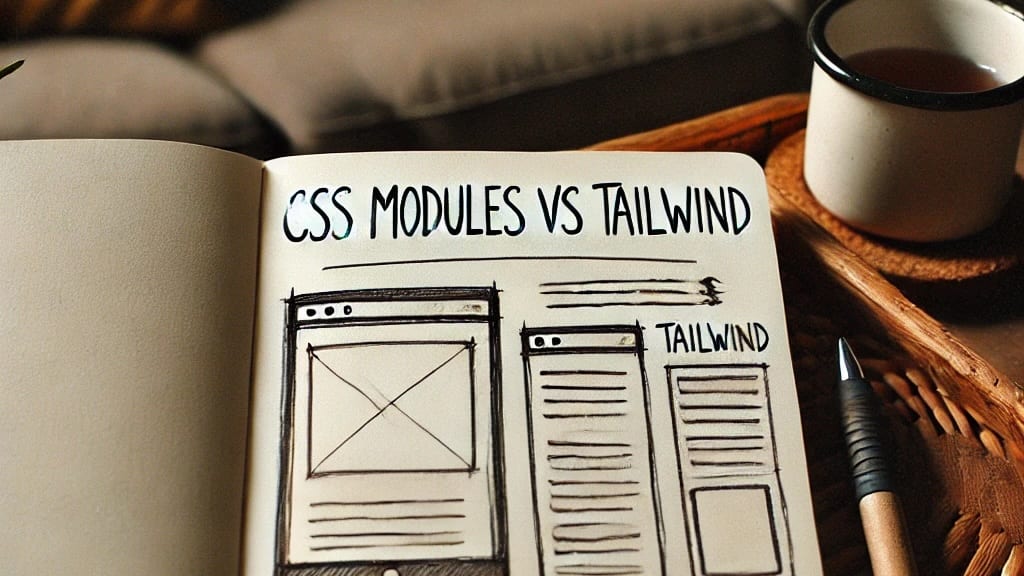Styling with CSS Modules vs. Tailwind CSS: A Comparative Guide
Introduction
The evolving landscape of front-end development has brought forth powerful tools like CSS Modules and Tailwind CSS, each offering unique approaches to styling. This post explores the key differences, advantages, and use cases of CSS Modules and Tailwind CSS, helping you choose the best tool for your next project.
Overview of CSS Modules and Tailwind CSS
CSS Modules
CSS Modules offer scoped, component-specific styling, preventing global style leakage. They generate unique class names, ensuring that styles do not conflict across the application.
Tailwind CSS
Tailwind CSS is a utility-first CSS framework that provides a set of predefined classes, enabling developers to rapidly build user interfaces directly in the markup.
Key Differences Between CSS Modules and Tailwind CSS
| Feature | CSS Modules | Tailwind CSS |
|---|---|---|
| Approach to Styling | Scoped styles with component-specific classes | Utility-first styling with low-level utility classes |
| Class Naming | Auto-generated, locally scoped | Predefined set of utility class names |
| Scoping | Automatic, prevents conflicts | No scoping, relies on utility classes |
| File Management | Separate CSS files for each component | Single, large CSS file generated from config |
| Customization | Custom styles per component | Configurable through a central config file |
| Development Workflow | Manual writing and maintenance of CSS | Rapid development with utility classes |
| Learning Curve | Basic understanding of CSS required | Learning utility-first approach and class names |
| File Size | Smaller, only necessary styles written | Initially large, can be optimized |
| Responsiveness | Manual media queries | Built-in responsive utility classes |
| Component Reusability | Promotes encapsulated, reusable components | Consistency through shared utility classes |
When to Use CSS Modules
Example Scenario: Large Enterprise Application with Complex UIs
CSS Modules are ideal for large-scale applications where strict style encapsulation is necessary. The use of scoped styles prevents conflicts, making it easier to maintain a clean and organized codebase, especially in a team environment.
Benefits:
- Scoped styles prevent conflicts
- Easier maintainability in large codebases
- Flexibility for detailed, component-specific styling
When to Use Tailwind CSS
Example Scenario: Rapid Prototyping for a Startup's MVP
Tailwind CSS is perfect for scenarios requiring quick iterations and consistent design language, such as building an MVP. Its utility-first approach accelerates development, reduces the need for custom CSS, and maintains a cohesive look across the project.
Benefits:
- Quick development with utility-first classes
- Consistent design language across the project
- Minimized custom CSS and streamlined workflow
Practical Examples
Styling a Marketing Banner with a CTA
CSS Modules Implementation
HTML:
<div className={styles.banner}>
<h1 className={styles.title}>Try pi today!</h1>
<a href="/sign-up" className={styles.ctaButton}>Get Started</a>
</div>
CSS Module (styles.module.css):
.banner {
background-color: #4a90e2;
padding: 40px;
text-align: center;
border-radius: 10px;
}
.title {
font-size: 48px;
color: #ffffff;
font-family: 'Arial, sans-serif';
margin-bottom: 20px;
}
.ctaButton {
display: inline-block;
background-color: #ffffff;
color: #4a90e2;
padding: 15px 30px;
text-decoration: none;
border-radius: 5px;
font-size: 20px;
font-family: 'Arial, sans-serif';
transition: background-color 0.3s ease;
}
.ctaButton:hover {
background-color: #f1f1f1;
}
Tailwind CSS Implementation
HTML:
<div class="bg-blue-500 p-10 text-center rounded-lg">
<h1 class="text-white text-4xl font-sans mb-5">Try pi today!</h1>
<a href="/sign-up" class="inline-block bg-white text-blue-500 py-3 px-6 rounded-md text-lg font-sans transition-colors duration-300 hover:bg-gray-200">
Get Started
</a>
</div>
Conclusion
Both CSS Modules and Tailwind CSS offer unique benefits depending on the project's requirements. CSS Modules provide strict style encapsulation and detailed customization, making them ideal for large, complex applications. In contrast, Tailwind CSS excels in rapid development and maintaining a consistent design, perfect for fast-paced environments like startups.
Choosing between these tools ultimately depends on your specific needs, the complexity of your project, and your team's workflow preferences. Experiment with both to find what best suits your development style.
